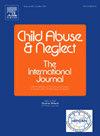儿童虐待、非自杀性自我伤害和青少年网络成瘾之间的关系:复杂创伤后应激障碍症状的纵向中介作用
IF 3.4
2区 心理学
Q1 FAMILY STUDIES
引用次数: 0
摘要
背景非自杀性自伤和网络成瘾是受环境因素影响的行为问题,儿童虐待是其中一个重要的危险因素。复杂创伤后应激障碍(CPTSD)与儿童虐待密切相关。目的探讨儿童虐待、自伤和网络成瘾之间的纵向关系,重点研究网络创伤后应激障碍症状的中介作用。本研究每隔6个月收集454名中国青少年的三波数据。儿童虐待在T1进行评估,而CPTSD症状、自伤和网络成瘾在T2和T3进行评估。方法采用路径分析方法,探讨儿童虐待对自伤和网络成瘾的直接和间接影响,其中两类CPTSD症状:创伤后应激障碍(PTSD)和自组织障碍(DSO)。结果scptsd症状在儿童虐待与两种行为问题的关系中起部分中介作用,其中DSO症状在其中起主要中介作用。其中,情感失调和负性自我概念分别是网络成瘾和自伤的主要中介因素。结论受虐待青少年的CPTSD症状,尤其是DSO症状对行为问题有显著影响。这项研究强调了将CPTSD症状纳入针对受虐待青少年适应不良行为的循证干预措施的必要性。本文章由计算机程序翻译,如有差异,请以英文原文为准。
Associations among child maltreatment, non-suicidal self-injury and internet addiction in adolescents: Longitudinal mediation of symptoms of complex posttraumatic stress disorder
Backgrounds
Non-suicidal self-injury (NSSI) and internet addiction are behavioral problems influenced by environmental factors, with child maltreatment emerging as an important risk factor. Complex posttraumatic stress disorder (CPTSD) is closely associated with child maltreatment.
Objective
This study aimed to explore the longitudinal associations among child maltreatment, NSSI and internet addiction, focusing on the mediating role of CPTSD symptoms.
Participants and setting
This study collected three-wave data from 454 Chinese adolescents with a six-month interval. Child maltreatment was assessed at T1, while CPTSD symptoms, NSSI and internet addiction were assessed at both T2 and T3.
Methods
Path analysis was utilized to examine both direct and indirect effects of child maltreatment on NSSI and internet addiction, mediated by two clusters of CPTSD symptoms: posttraumatic stress disorder (PTSD) and disturbance in self-organization (DSO).
Results
CPTSD symptoms partially mediated the relationship between child maltreatment and the two behavioral problems, with DSO symptoms being the primary contributors to this mediating effect. Specifically, affective dysregulation and negative self-concept in DSO were key mediators for internet addiction and NSSI respectively.
Conclusions
Among adolescents with child maltreatment, CPTSD symptoms, especially DSO symptoms, exert a significant influence on behavioral problems. This study underscores the need to integrate CPTSD symptoms into evidence-based interventions targeting maladaptive behaviors in maltreated youth.
求助全文
通过发布文献求助,成功后即可免费获取论文全文。
去求助
来源期刊

Child Abuse & Neglect
Multiple-
CiteScore
7.40
自引率
10.40%
发文量
397
期刊介绍:
Official Publication of the International Society for Prevention of Child Abuse and Neglect. Child Abuse & Neglect The International Journal, provides an international, multidisciplinary forum on all aspects of child abuse and neglect, with special emphasis on prevention and treatment; the scope extends further to all those aspects of life which either favor or hinder child development. While contributions will primarily be from the fields of psychology, psychiatry, social work, medicine, nursing, law enforcement, legislature, education, and anthropology, the Journal encourages the concerned lay individual and child-oriented advocate organizations to contribute.
 求助内容:
求助内容: 应助结果提醒方式:
应助结果提醒方式:


